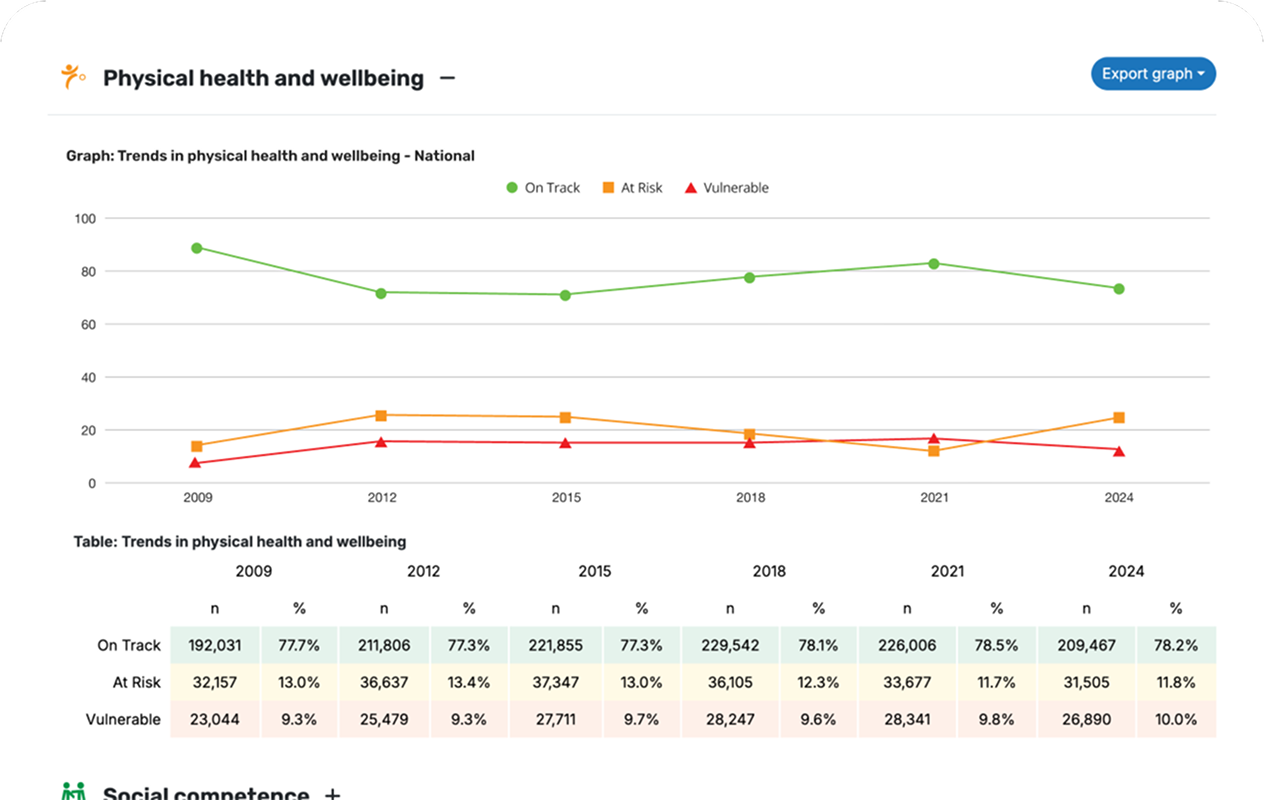
Date: June 2024
AEDC Cycle: Cycle 1 (2009), Cycle 2 (2012), Cycle 3 (2015), Cycle 4 (2018), Cycle 5 (2021)
States: ACT, NSW, NT, QLD, SA, TAS, VIC, WA
Data Linkage Project: No
Organisation: Health Research Institute, Faculty of Health, University of Canberra
Early childhood is an important period to lay good foundations for future health and wellbeing. Thus, it is critical to understand factors influencing developmental vulnerability that may prevent young children from having good health and well-being. Previous studies have found several early childhood developmental vulnerability predictors, including individual child, parent/family, and neighbourhood characteristics. However, the relationship between neighbourhood social fragmentation and early childhood developmental vulnerability is unclear. Thus, this research aims to investigate the association between neighbourhood social fragmentation and developmental vulnerability in early childhood.
Date: June 2024
AEDC Cycle: Cycle 1 (2009), Cycle 2 (2012), Cycle 3 (2015), Cycle 4 (2018), Cycle 5 (2021)
States: ACT, NSW, NT, QLD, SA, TAS, VIC, WA
Data Linkage Project: No
Organisation: Education Futures, University of South Australia
The report will demonstrate what we know about the links between a child attending playgroup and being developmentally ‘on track’ or vulnerable when they start school. This is a re-examination using the latest wave of data to replicate previous analysis done looking at the impact of Playgroup attendance on child development indicators.
The previous report had two primary aims:
- To explore changes in Playgroup attendance between 2012, 2015, and 2018 AEDC waves.
- To explore the change in impact of Playgroup attendance on child development in the 2018, 2015, and 2012 AEDC waves.
Date: June 2024
AEDC Cycle: Cycle 1 (2009), Cycle 2 (2012), Cycle 3 (2015), Cycle 4 (2018), Cycle 5 (2021)
States: ACT, NSW, NT, QLD, SA, TAS, VIC, WA
Data Linkage Project: No
Organisation: Education Futures, University of South Australia
Settlement Services International (SSI) is interested in updating descriptive statistics supporting evidence for Culturally and Linguistically Diverse (CALD) children and investigating its relationship with child development as measured by the AEDC.
Date: January 2024
AEDC Cycle: Cycle 1 (2009), Cycle 2 (2012), Cycle 3 (2015), Cycle 4 (2018), Cycle 5 (2021)
States: ACT, NSW, NT, QLD, SA, TAS, VIC, WA
Data Linkage Project: No
Organisation: Monash University
Early childhood development (ECD) is an integral part of a child’s future. When ECD is supported, children are given the opportunity to reach their full developmental potential and lay a strong foundation for future growth and development. Internationally, governments and agencies have shown a strong commitment to optimising ECD, particularly through the United Nations Sustainable Development Goals and the Nurturing Care Framework for Early Childhood Development (WHO, UNICEF and the World Bank).
This project will provide the evidence on the development of several vulnerable groups of children. It will inform policy, education system and programs aiming to optimise ECD in Australia.
Date: January 2024
AEDC Cycle: Cycle 1 (2009), Cycle 2 (2012), Cycle 3 (2015), Cycle 4 (2018)
States: VIC
Data Linkage Project: No
Organisation: Monash University
The second aim is to identify predictors of developmental vulnerability at the individual level. The project will look at associations between predictors and outcomes (developmental vulnerability), as well as between predictors. In addressing this aim, the project will look at predictors across two levels: a lower level of family, parental and child characteristics, and an upper level, including LGA characteristics.
Date: December 2019
AEDC Cycle: Cycle 1 (2009), Cycle 2 (2012), Cycle 3 (2015)
States: NSW
Data Linkage Project: No
Organisation: Centre for Social Impact, The University of New South Wales
The Hive was established in 2015 with funding from NSW Family and Community Services (FACS) and private philanthropists. The Hive (under United Way Australia management) was established with the purpose of breaking the cycle of negative early childhood outcomes for children in Mt Druitt. In 2017 NSW FACS provided funding for The Hive to coordinate a cross-sector project to find solutions to issues preventing all children in Mt Druitt attending at least the minimum recommended hours.
This project aimed to explore characteristics – demographics, social, cognitive or behavioural – which may be related to a lack of engagement with Early Childhood Education and Care with the primary goal of finding targeted ways to break the cycle of disadvantage for children in Mt Druitt, including through ensuring consistent access to high quality education from the youngest age.
Mt Druitt had a higher rate of education disengagement relative to the rest of Australia in 2017 and addressing the importance of early childhood education provides new strategies where cycles of disadvantage can be broken.
The AEDC data was used for descriptive purposes and explored whether there were particular characteristics or groups of children who did not engage with ECEC.Date: September 2016
AEDC Cycle: Cycle 1 (2009), Cycle 2 (2012), Cycle 3 (2015)
States: QLD, VIC, WA
Data Linkage Project: Yes
Organisation: School of Population Health, The University of Western Australia
Date: May 2015
AEDC Cycle: Cycle 1 (2009), Cycle 2 (2012)
States: ACT, NSW, NT, QLD, SA, TAS, VIC, WA
Data Linkage Project: No
Organisation: National Centre for Student Equity in Higher Education
The Australian Government Department of Education and Training has engaged the National Centre for Student Equity in Higher Education (NCSEHE) at Curtin University to develop the Equity Performance Framework for Australian Higher Education (“the Framework”). Following its implementation, the Framework is expected to: (i) Provide a set of indicators that will allow the measurement of achievement against the Government’s commitments, targets and goals in relation to equity; (ii) Inform policy through the provision of relevant information to support the development of evidence based policy; (iii) Foster informed debate through the provision of key information; (iv) Provide a platform which will guide evaluation of programs by government and activities by institutions; and (v) Inform practice within, and support equity in, the higher education system.
Date: May 2015
AEDC Cycle: Cycle 1 (2009), Cycle 2 (2012)
States: ACT, NSW, NT, QLD, SA, TAS, VIC, WA
Data Linkage Project: Yes
Organisation: Joint study between: Telethon Kids Institute; University of Adelaide; University of New South Wales; Menzies School of Health Research; University of South Australia; Department of Education and Training; Tasmanian Department of Education; South Australian Department for Education and Child Development; New South Wales Department of Education and Communities; Australian National University; ACT Health; Northern Territory Department of Health.
The Australian Early Development Census (AEDC) National Report provides state comparison on the AEDC domains but does not investigate variation across states and how this variation can (or cannot) be explained by the social and demographic profiles of the states. This work finds that there is large variation in the level of developmental vulnerability between Australian jurisdictions even after adjusting for key demographic and socioeconomic factors. The results show that there are also socioeconomic inequalities in the proportion of children developmentally vulnerable within jurisdictions. Policy differences and variation in the mix of universal and targeted early childhood services between jurisdictions may help to explain the inequality between and within jurisdictions.
Date: May 2015
AEDC Cycle: Cycle 1 (2009), Cycle 2 (2012)
States: ACT, NSW, NT, QLD, SA, TAS, VIC, WA
Data Linkage Project: Yes
Organisation: Royal Children's Hospital
The importance of early life programming on later health and developmental inequalities has become clear. However, the necessary Australian data on the epidemiology and pathways of inequalities to inform policies and programs remains limited. This project uses the Longitudinal Study of Australian Children Study (LSAC) B cohort linked with the 2009 AEDI data of this cohort, to examine disparities in children’s developmental outcomes with a particular focus on Children with Special Health Care needs, a language background other than English and mental health concerns. Linking the AEDI with the longitudinal data (LSAC) will allow the identification of both predictors and correlates of developmental outcomes at school entry at the individual, family and community level, and has the potential to translate to policy implications.
AEDC Cycle: Cycle 2 (2012)
States: ACT, NSW, NT, QLD, SA, TAS, VIC, WA
Data Linkage Project: No
Organisation: National Centre for Social and Economic Modelling
The project will update the CSE Index by incorporating the new 2011 Census data, the 2012 AEDI data and other data at small area level (SLA).
Date: June 2014
AEDC Cycle: Cycle 1 (2009)
States: NSW
Data Linkage Project: No
Organisation: South Western Sydney Local Health District
This research examines whether the AEDI domains are spatially correlated with variables including social cohesion, social capital, social disadvantage, aggregated ethnicity, measures of segregation/integration, rates of non-English speaking, aggregated rates of social networking, and utilisation rates of universal early childhood nursing services. Further, it investigates whether these associations remain when controlling for individual level factors such as English as a second language and attendance at Early Childhood Education.
Date: May 2014
AEDC Cycle: Cycle 1 (2009), Cycle 2 (2012)
States: ACT, NSW, NT, QLD, SA, TAS, VIC, WA
Data Linkage Project: No
Organisation: School of Population Health, University of Adelaide
Research has established that children of higher socioeconomic status experience better child development outcomes than children of lower socioeconomic status (SES). This project examines inequality in SES within and between jurisdictions and how this relates to children’s AEDI outcomes. In addition, it explores communities in which children are performing better on the AEDI than one would expect given the SES of the community in which they live with a particular focus on Indigenous communities.
Community Data Explorer
Navigate the AEDC Community Data Explorer and understand the data.
